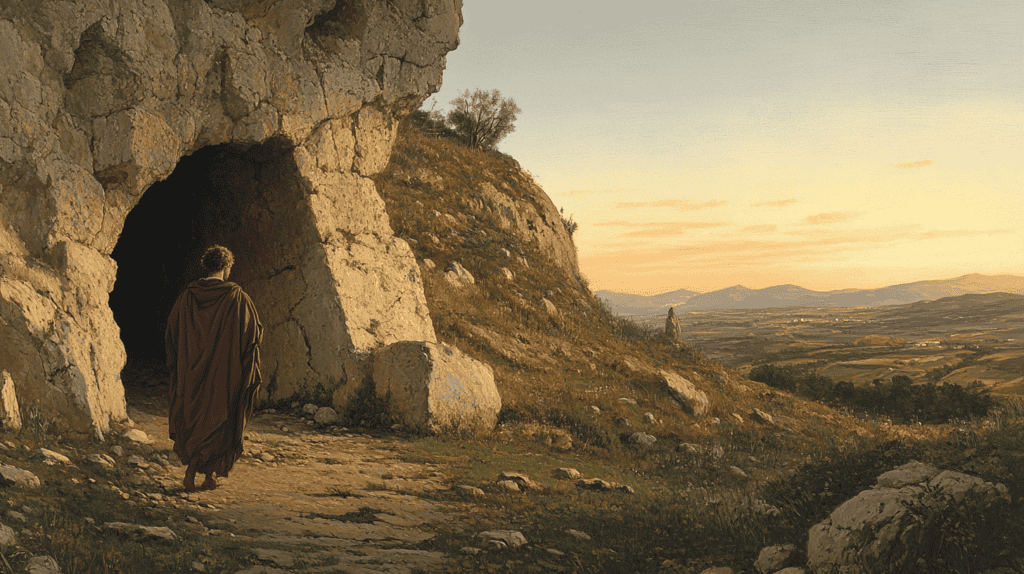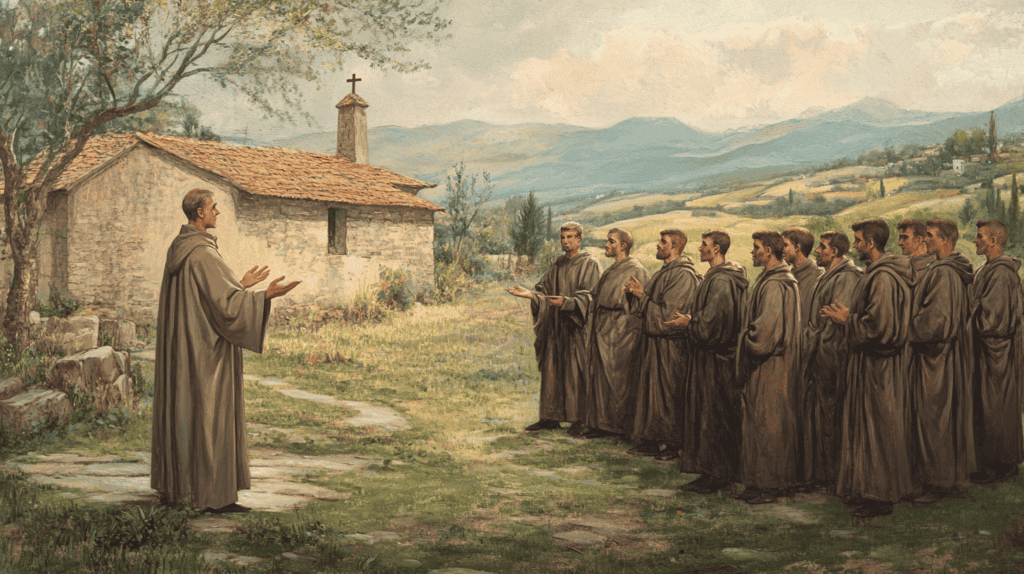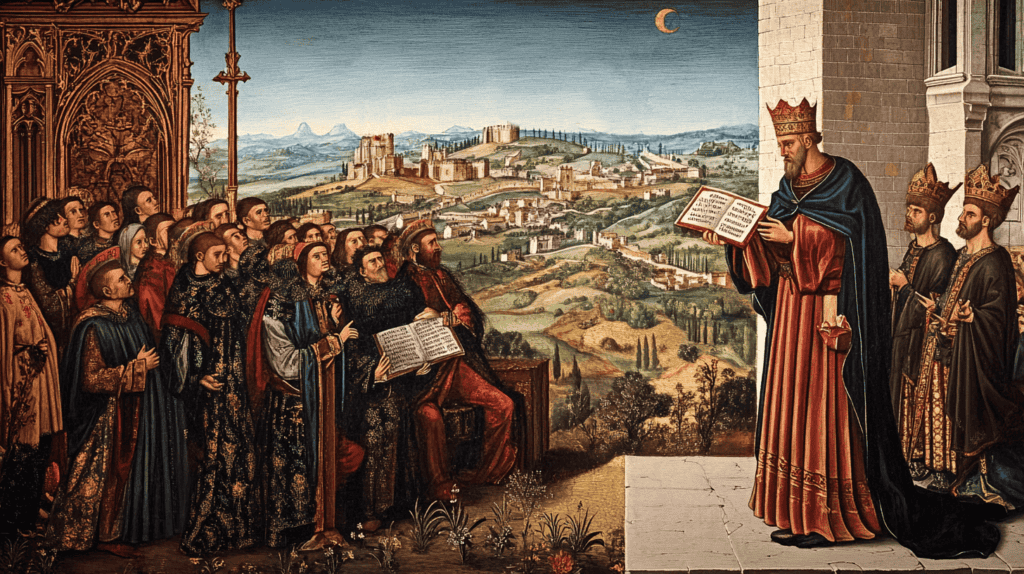
In the early 6th century, a pivotal moment in European history unfolded on a rocky hill in central Italy. There, Benedict of Nursia established the monastery of Monte Cassino, laying the foundation for what would become one of the most influential monastic traditions in Western civilization. This event not only shaped the religious landscape of Europe but also had profound impacts on education, culture, and social structures for centuries to come.
The Early Life of Benedict
Benedict was born around 480 CE in Nursia, a small town in the Umbrian mountains of central Italy. Born into a noble family, he was sent to Rome as a young man to pursue his studies. However, the young Benedict found himself disillusioned with the decadent lifestyle he encountered in the once-great imperial capital.
Seeking a more meaningful existence, Benedict made a radical decision. He abandoned his studies and worldly pursuits, choosing instead to dedicate his life to God. This decision led him to Subiaco, a rugged area about 40 miles east of Rome. There, Benedict retreated to a cave, determined to live as a hermit and devote himself entirely to prayer and contemplation.

The Birth of a Community
Benedict’s solitary existence in Subiaco did not last long. His reputation for holiness and wisdom soon attracted others who sought to learn from him and emulate his way of life. Gradually, a community began to form around Benedict, with like-minded individuals drawn to his teachings and example.
This growing community marked a significant shift in Benedict’s approach. He began to see the value of communal living in the pursuit of spiritual growth. Rather than advocating for solitary hermitage, Benedict started to promote the idea of monks living and worshiping together as a community. This concept of communal monasticism would become one of the defining features of the Benedictine Order.

The Journey to Monte Cassino
Despite the flourishing community in Subiaco, Benedict’s path was not without challenges. According to tradition, some members of his community, finding his rule too strict, attempted to poison him. Miraculously, when Benedict blessed the poisoned wine, the cup shattered, sparing his life.
This incident prompted Benedict to leave Subiaco with a group of loyal followers. Their journey led them to Monte Cassino, a hill about 80 miles southeast of Rome. The site Benedict chose for his new monastery was steeped in history and symbolism. Atop the hill stood an ancient pagan temple dedicated to Apollo, a remnant of the area’s pre-Christian past.

Founding of Monte Cassino
Benedict and his followers arrived at Monte Cassino around the year 529 CE7. Their first act was deeply symbolic: they destroyed the pagan temple and altar dedicated to Apollo. This act represented not just the physical transformation of the site, but also the spiritual transformation Benedict envisioned for the entire region.
On the ruins of the pagan temple, Benedict began the construction of a Christian monastery. He dedicated two oratories on the site: one to Saint Martin of Tours and another to Saint John the Baptist. These dedications were significant, linking the new foundation to important figures in Christian history and emphasizing the monastery’s role in continuing the Christian mission.
The Rule of Saint Benedict
It was at Monte Cassino that Benedict composed his famous Rule, a document that would shape monastic life in Western Europe for centuries to come. The Rule of Saint Benedict was a comprehensive guide for monastic living, covering everything from the daily schedule of prayer and work to the principles of community organization and leadership.

Key elements of the Rule included:
Ora et Labora (Prayer and Work): This motto encapsulated Benedict’s vision of a balanced monastic life. Monks were to divide their time between prayer, study, and manual labor.
Stability: Benedict emphasized the importance of monks remaining committed to their community, discouraging the wandering lifestyle that was common among some earlier monastic traditions.
Obedience: The Rule stressed the importance of obedience to the abbot and to the community’s rules, seeing this as a path to humility and spiritual growth.
Moderation: Unlike some more extreme ascetic traditions, Benedict advocated for a moderate approach to fasting and other physical disciplines.
Hospitality: The Rule placed great emphasis on welcoming guests and travelers, seeing Christ in every visitor.
The Rule was remarkable for its practicality and flexibility. It provided a framework that could be adapted to different times and places, which contributed to its enduring influence.
Life at Monte Cassino
Under Benedict’s leadership, Monte Cassino quickly became a model of monastic life. The daily rhythm of the monastery was structured around the liturgical hours, with the monks gathering multiple times a day for communal prayer and the celebration of Mass.
Between these times of prayer, the monks engaged in a variety of activities. Some worked in the fields, cultivating crops and tending to livestock. Others labored in workshops, producing goods for the monastery’s use and for trade. Still others devoted themselves to study and the copying of manuscripts, a practice that would prove crucial in preserving knowledge through the tumultuous centuries ahead.
The monastery also served as a center of hospitality and charity. Travelers, pilgrims, and the poor were welcomed and cared for, in accordance with Benedict’s instruction to see Christ in every guest.

The Spread of Benedictine Monasticism
While Benedict himself never set out to create a widespread monastic order, his Rule and the example of Monte Cassino proved immensely influential. As news of the monastery spread, other communities began to adopt Benedict’s Rule, recognizing its wisdom and practicality.
The destruction of Monte Cassino by the Lombards in 580 CE, while tragic, paradoxically contributed to the spread of Benedictine monasticism. The displaced monks fled to Rome, bringing with them Benedict’s teachings and way of life. From there, Benedictine monasticism began to spread throughout Italy and beyond.
The Rule’s flexibility allowed it to be adapted to various cultural contexts across Europe. By the time of Charlemagne in the late 8th and early 9th centuries, the Benedictine Rule had become the standard for Western monasticism. Charlemagne himself played a crucial role in promoting and standardizing the Benedictine model throughout his empire.

Impact on European Civilization
The establishment of Monte Cassino and the spread of Benedictine monasticism had far-reaching effects on European civilization:
Preservation of Knowledge: Benedictine monasteries became crucial centers of learning during the Early Middle Ages. Monks diligently copied manuscripts, preserving classical texts that might otherwise have been lost.
Education: Monasteries often served as schools, providing education not just for future monks but also for local communities.
Agricultural Innovation: Monastic communities were often at the forefront of agricultural development, introducing new crops and farming techniques.
Social Services: Monasteries provided essential social services, including healthcare and care for the poor, in an era when such institutions were scarce.
Cultural Unification: The spread of Benedictine monasticism helped create a common cultural framework across diverse regions of Europe.
Spiritual Renewal: The Benedictine emphasis on communal life and balanced spirituality offered an attractive alternative to both extreme asceticism and worldly corruption.
Monte Cassino Through the Ages
While Benedict’s original monastery at Monte Cassino was destroyed by the Lombards in 580 CE, the site remained an important center of Benedictine monasticism. It was rebuilt several times over the centuries, each time rising from destruction to continue its mission.
During the Middle Ages, Monte Cassino reached the height of its influence. In 1057, Pope Victor II recognized the abbot of Monte Cassino as having precedence over all other abbots. The monastery became a major center of art and learning, commissioning works from Byzantine artisans and maintaining a rich library.
Monte Cassino’s strategic location also made it a target during times of conflict. It was sacked by Saracens in 883 and again rebuilt. During World War II, the monastery was tragically destroyed in an Allied bombing raid, under the mistaken belief that it was being used as a German observation post. After the war, it was painstakingly reconstructed to match its pre-war appearance.

The Benedictine Legacy Today
Today, over 1,500 years after Benedict established his monastery at Monte Cassino, the Benedictine tradition continues to thrive. There are Benedictine monasteries and convents on every continent, each following the essential principles laid down by Benedict while adapting to local needs and cultures.
The rebuilt Abbey of Monte Cassino stands as a powerful symbol of resilience and continuity. It continues to be an active monastery, home to a community of monks who follow the Rule of Saint Benedict. The abbey also serves as a pilgrimage site and a repository of art and history.
The establishment of Monte Cassino by Benedict of Nursia in 529 CE was a watershed moment in European history. From this rocky hill in central Italy, a new vision of monastic life spread across the continent, shaping not just religious practice but the very fabric of medieval society.





